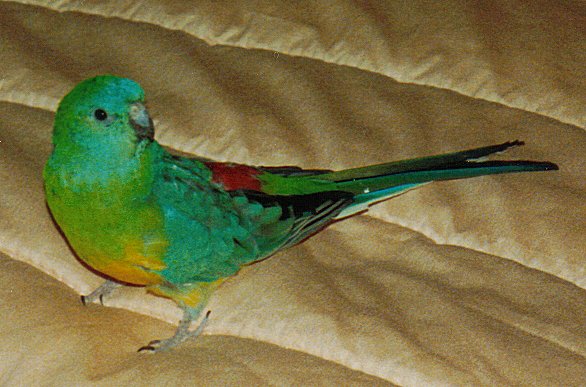
Red-rumped parrot, orRed-backed parrot, orGrass parrot(Psephotus haematonotus)
Phylum —chordata
Class — aves
Order — psittaciformes
Family — psittaculidae
Genus – psephotus
Subspecies:
- Psephotus haematonotus caeruleus;
- Psephotus haematonotus haematonotus.
Appearance
Red-rumped parrots are slim, moderate-sized parrots approximately 28 cm (11 in) in length. The male's plumage is a bright emerald-green with yellow underparts, a brick-red rump and blue highlights on the wings and upper back. The female's plumage is less vibrant, with pale olive underparts, dull green wings and back and blue-black wingtips. The characteristic red rump is only found in the male.
Habitat
These parrots are considered as a common bird of southeastern Australia. They are found in many regions, including southern Queensland, Victoria, the Lake Eyre basin, and the Murray-Darling Basin.
Behavior
Red-rumped parrots can be found in pairs or flocks in open country with access to water. They avoid the coast and the wetter, more heavily wooded areas. Clearing of large tracts of forest and the provision of water for stock has probably extended their range. They are often seen in suburban parks and gardens. Their green plumage provides such a good camouflage in ankle length grasses that they can hide quite effectively until the viewer is only 10–20 meters away.
They spend a great deal of time feeding on the ground, and often call to one another with an attractive chee chillip chee chillip.
Diet
Considering that these are grass parrots, their primary source of food in the wild consists of grass seeds. It also includes herb seeds, blossoms, fruits, and insects.
Reproduction
Like many parrots, red-rumped parrots nest in tree hollows or similar places, including fenceposts and stumps. They lay 3-6 white eggs, breeding usually takes place in spring, however, in the dryer inland areas, breeding can occur at any time of year in response to rainfall.
In captivity
In captivity, if properly cared for, these birds will live from 15 to 32 years.
Red-rumped parrots need plenty of wing exercise, so they enjoy a fairly large, oblong aviary. The parrots should have nontoxic leafy branches for perching and chewing, and outdoor aviaries should contain a dry, frost-proof shelter. To maintain the bird's feathers in good condition, keepers should provide clean bathing water daily.
Red-rumped parrots like to forage off the ground. They require plenty of fresh fruit - including apples, pears and oranges - and green leafy vegetables. A good seed mixture is small parrot mix, combined with canary seed and a little sunflower seed. You must also provide cuttlefish bone and grit.
This species is hardy, but is prone to worm infestations. Take your birds to the veterinarian regularly for deworming.
 Russian
Russian
 English
English























